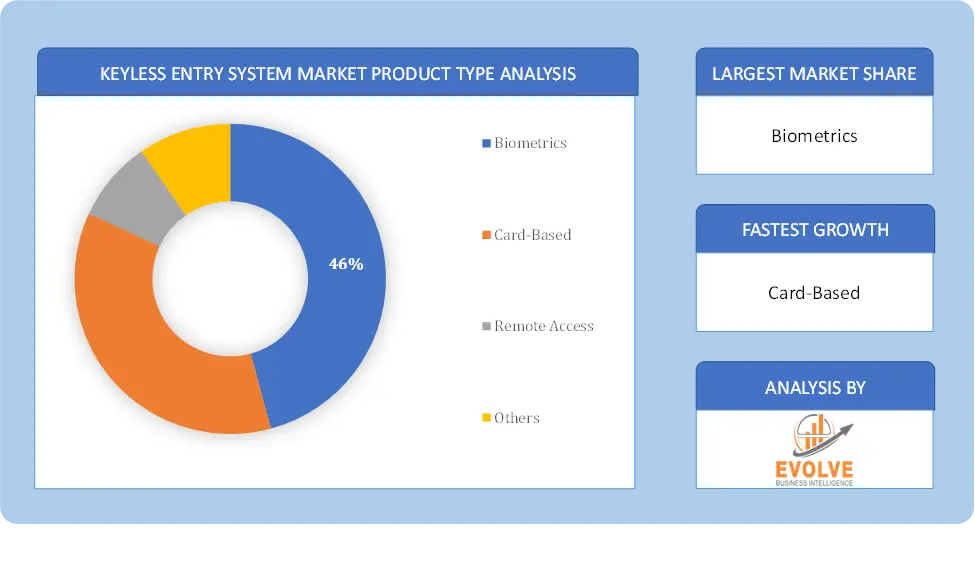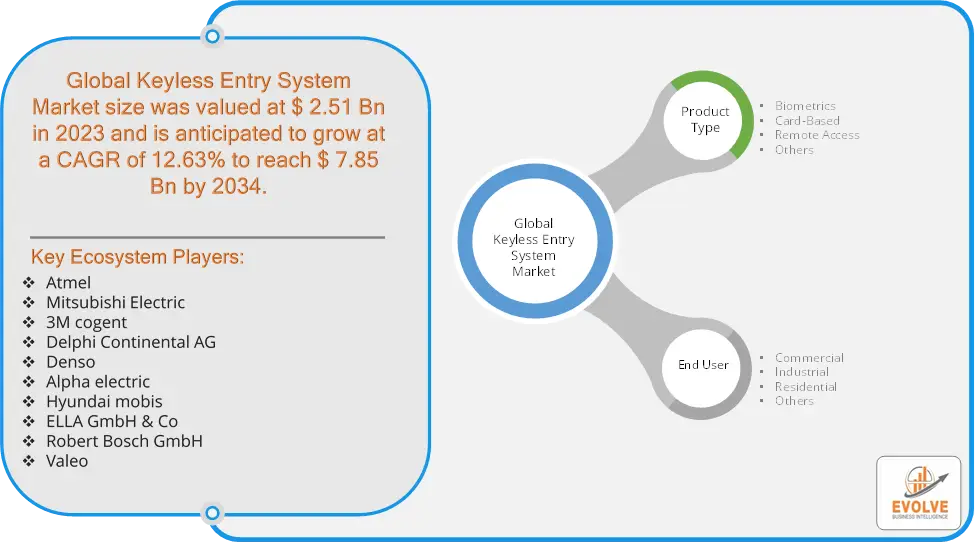Keyless Entry System Market Overview
The Keyless Entry System Market size accounted for USD 2.51 Billion in 2023 and is estimated to account for 3.68 Billion in 2024. The Market is expected to reach USD 7.85 Billion by 2034 growing at a compound annual growth rate (CAGR) of 12.63% from 2024 to 2034. A keyless entry system is a technology that allows a person to unlock and lock a vehicle without using a physical key. It typically uses radio frequency identification (RFID) or near-field communication (NFC) technology to detect a key fob or smartphone within a certain proximity of the vehicle.
The key factors driving this market include increasing demand for convenience and security, advancements in technology (like IoT integration), and the growing trend of smart homes and smart vehicles. Major applications include automotive, residential, commercial, and industrial sectors. The market’s growth is influenced by rising concerns over security and theft, along with evolving consumer preferences for automated systems.
Global Keyless Entry System Market Synopsis
 Keyless Entry System Market Dynamics
Keyless Entry System Market Dynamics
The major factors that have impacted the growth of Keyless Entry System Market are as follows:
Drivers:
Ø Technological Advancements
Innovations such as smartphone integration, biometric authentication (fingerprints, facial recognition), and IoT connectivity are making keyless entry systems more attractive and user-friendly. The increasing popularity of smart home technologies is driving demand for integrated keyless entry systems that enhance home automation and security. Over time, keyless entry systems can reduce the costs associated with key duplication and lost keys, making them an appealing option for both residential and commercial users.
Restraint:
- Perception of High Initial Costs and Technical Complexity
The installation and integration of keyless entry systems can be expensive, which may deter some consumers and businesses from adopting this technology. The complexity of these systems can result in difficulties with installation, maintenance, and troubleshooting, which may discourage some users. Many keyless entry systems rely on batteries for operation, and the potential for battery failure can pose a significant inconvenience for users.
Opportunity:
⮚ Integration with Smart Technologies
The increasing adoption of smart home devices and IoT solutions offers opportunities to develop integrated keyless entry systems that work seamlessly with other smart home technologies. Growing urbanization and rising disposable incomes in emerging economies provide a significant opportunity for keyless entry systems in both residential and commercial sectors. Developing advanced security features, such as biometric authentication and encryption, can help address consumer concerns about hacking and enhance the appeal of keyless entry systems. The push for sustainable building practices can drive the demand for energy-efficient keyless entry systems, particularly in new construction projects.
Keyless Entry System Market Segment Overview
By Product Type
 Based on Product Type, the market is segmented based on Biometrics, Card-Based, Remote Access and Others. The Remote Access segment dominant the market. Users can unlock or start their vehicles without using a physical key, often with the press of a button on a remote fob. Many modern systems allow access via mobile apps, enabling users to lock/unlock doors, start engines, or check security status remotely and some remote access systems leverage cloud technology to enable real-time monitoring and control from anywhere.
Based on Product Type, the market is segmented based on Biometrics, Card-Based, Remote Access and Others. The Remote Access segment dominant the market. Users can unlock or start their vehicles without using a physical key, often with the press of a button on a remote fob. Many modern systems allow access via mobile apps, enabling users to lock/unlock doors, start engines, or check security status remotely and some remote access systems leverage cloud technology to enable real-time monitoring and control from anywhere.
By End User
Based on End Users, the market segment has been divided into Commercial, Industrial, Residential and Others. The Residential segment dominant the market. Residential keyless entry systems often integrate with other smart home devices, such as security cameras, alarms, and home automation systems and some high-end residential solutions offer fingerprint or facial recognition for enhanced security and convenience.
Global Keyless Entry System Market Regional Analysis
Based on region, the global Keyless Entry System Market has been divided into North America, Europe, Asia-Pacific, the Middle East & Africa, and Latin America. North America is projected to dominate the use of the Keyless Entry System Market followed by the Asia-Pacific and Europe regions.
 Keyless Entry System North America Market
Keyless Entry System North America Market
North America holds a dominant position in the Keyless Entry System Market. North America holds a significant share of the keyless entry system market due to high adoption rates in both automotive and residential sectors and the presence of major automotive manufacturers and tech companies drives innovation and development in smart and secure entry systems.
Keyless Entry System Asia-Pacific Market
The Asia-Pacific region has indeed emerged as the fastest-growing market for the Keyless Entry System Market industry. Rapid urbanization and rising disposable incomes in countries like China and India present significant growth opportunities and increasing automotive production and sales in the region are driving demand for keyless entry systems. Growing interest in smart technologies and security solutions is contributing to market growth.
Competitive Landscape
The global Keyless Entry System Market is highly competitive, with numerous players offering a wide range of software solutions. The competitive landscape is characterized by the presence of established companies, as well as emerging startups and niche players. To increase their market position and attract a wide consumer base, the businesses are employing various strategies, such as product launches, and strategic alliances.
Prominent Players:
- Atmel
- Mitsubishi Electric
- 3M cogent
- Delphi Continental AG
- Denso
- Alpha electric
- Hyundai mobis
- ELLA GmbH & Co
- Robert Bosch GmbH
- Valeo
Scope of the Report
Global Keyless Entry System Market, by Product Type
- Biometrics
- Card-Based
- Remote Access
- Others
Global Keyless Entry System Market, by End User
- Commercial
- Industrial
- Residential
- Others
Global Keyless Entry System Market, by Region
- North America
- US
- Canada
- Mexico
- Europe
- UK
- Germany
- France
- Italy
- Spain
- Benelux
- Nordic
- Rest of Europe
- Asia Pacific
- China
- Japan
- South Korea
- Indonesia
- Austalia
- Malaysia
- India
- Rest of Asia Pacific
- South America
- Brazil
- Argentina
- Rest of South America
- Middle East & Africa
- Saudi Arabia
- UAE
- Egypt
- South Africa
- Rest of Middle East & Africa
| Parameters | Indicators |
|---|---|
| Market Size | 2033: $ 7.85 Billion |
| CAGR | 12.63% CAGR (2023-2033) |
| Base year | 2022 |
| Forecast Period | 2023-2033 |
| Historical Data | 2021 |
| Report Coverage | Revenue Forecast, Competitive Landscape, Growth Factors, and Trends |
| Key Segmentations | Product Type, End User |
| Geographies Covered | North America, Europe, Asia-Pacific, Latin America, Middle East, Africa |
| Key Vendors | Atmel, Mitsubishi Electric, 3M cogent, Delphi Continental AG, Denso, Alpha electric, Hyundai mobis, ELLA GmbH & Co, Robert Bosch GmbH and Valeo |
| Key Market Opportunities | • Integration with Smart Technologies • Enhanced Security Features |
| Key Market Drivers | • Technological Advancements • Growing Smart Home Adoption and Cost-Effectiveness |
REPORT CONTENT BRIEF:
- High-level analysis of the current and future Keyless Entry System Market trends and opportunities
- Detailed analysis of current market drivers, restraining factors, and opportunities in the future
- Keyless Entry System Market historical market size for the year 2021, and forecast from 2023 to 2033
- Keyless Entry System Market share analysis at each product level
- Competitor analysis with detailed insight into its product segment, Government & Defense strength, and strategies adopted.
- Identifies key strategies adopted including product launches and developments, mergers and acquisitions, joint ventures, collaborations, and partnerships as well as funding taken and investment done, among others.
- To identify and understand the various factors involved in the global Keyless Entry System Market affected by the pandemic
- To provide a detailed insight into the major companies operating in the market. The profiling will include the Government & Defense health of the company’s past 2-3 years with segmental and regional revenue breakup, product offering, recent developments, SWOT analysis, and key strategies.







